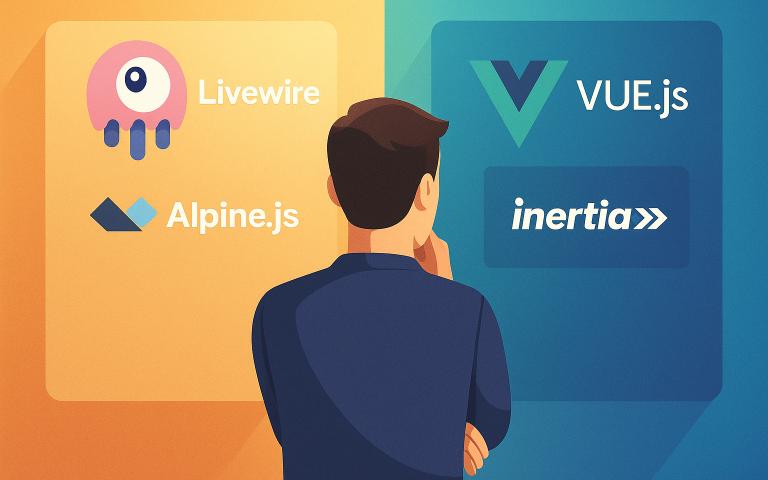Livewire+Alpine or Vue+Inertia: how to choose without regrets
At the start of a new project there’s often an odd pause: the business logic is clear, the team can handle both stacks, but the question “Livewire or Inertia?” hangs in the air. Both feel fine, yet the real concern is choosing in a way that won’t cause regrets a year later.

Two mental models: server-led vs browser-led
Livewire+Alpine is server-driven. State lives in PHP components; the client receives HTML diffs. You ship with less JavaScript, simpler deploys, and a Laravel-first mindset.
Vue+Inertia is browser-driven with an SPA feel (no separate API layer). The server returns props; Vue renders and handles navigation. You gain richer UX and mature frontend patterns, but you must manage bundles, caching, and sometimes SSR.
What really matters over the next 12–18 months
- Delivery speed (lead time): steps from ticket to release.
- Total Cost of Ownership (TCO): support, integrations, builds, incidents.
- Hiring & onboarding: who you can hire quickly and ramp fast.
- Performance & stability: TTFB/LCP, bundle weight, graceful degradation.
- SEO: where guaranteed server render is critical.
- Release reliability: sensitivity to dependency churn and build fragility.
- Testability: cost to cover critical flows.
Product types and natural fit
CRUD dashboards, B2B tools, forms, tables, filters typically shine with Livewire: rapid start, lower cognitive load, PHP-first tests. For complex interactive UIs—builders, kanban boards, editors, real-time collaboration, offline, long-lived client state—Inertia with Vue pays off.
Performance & operations
Livewire: smaller JS footprint and simpler ops. Watch for N+1 queries, heavy HTML diffs, and slow endpoints; otherwise the infrastructure is straightforward.
Inertia: power with discipline—bundle budgets, code splitting, preloads, caching, and sometimes an SSR node for public pages. In exchange, you control UX and state with precision.
SEO for public pages
Livewire returns server HTML by default, yielding predictable crawl and render. Inertia is fine for internal/authenticated pages. When marketing matters, either keep those routes as Blade/Livewire “islands” or add SSR/prerender for selected pages.
Team & hiring
Livewire amplifies a Laravel-centric team. Vue widens the hiring pool but requires conventions: component architecture, state patterns, and a testing strategy. Without this, you risk a JS sprawl.
Testing strategy
Livewire: PHP component and HTTP tests cover a lot with low setup.
Vue: Vitest for units/components + Playwright for E2E + typing for safety; powerful, but you must invest in pipeline setup and maintenance.
Common regret patterns
- Over-SPA-ing: choosing an SPA without UX need → longer releases and overheated frontends.
- Monolithic Livewire: giant components with heavy diffs and rising complexity.
- Mixing stacks without seams: blending Livewire and Inertia ad hoc—no clear route/layout boundaries—breeds bugs and cognitive load.
Hybrid architecture (“islands”)
Make seams explicit: marketing/SEO with Blade/Livewire; the app with Inertia/Vue. Enforce boundaries via route groups, layouts, or subdomains. Hybrids work when the seams are clear.
A weighted decision matrix
Score each 1–5 and multiply by the suggested weight:
| Criterion | Weight | Note |
|---|---|---|
| UI interactivity complexity | 0.25 | Kanban/editor/real-time increase the score |
| Time-to-market / budget pressure | 0.20 | Tighter → Livewire bias |
| SEO criticality | 0.15 | Higher → Livewire/SSR |
| Hiring & onboarding | 0.10 | Who can you hire tomorrow? |
| Client-side perf risk | 0.10 | Low-end devices, offline |
| Long-lived client state | 0.10 | Offline, sync, complex wizards |
| Automated testing needs | 0.10 | Depth of E2E/unit requirements |
Heuristic: if UI complexity and long-lived state are high while SEO is low → pick Vue+Inertia. If SEO and time-to-market drive the project → choose Livewire. Borderline? Use a hybrid.
Scenario A (B2B dashboard, SEO important, tight timelines)
Scores lean to Livewire; optionally introduce a small Inertia “island” for a single complex screen.
Scenario B (Complex editor with real-time, marketing separate)
Scores lean to Inertia/Vue. Keep marketing in Blade/Livewire or add SSR for a few public routes.
Migration without stopping delivery (30–60–90)
- Day 30: define seams (route groups/layouts); pick candidates for migration; introduce linting and bundle budgets (Vue) or split oversized Livewire components.
- Day 60: migrate 1–2 high-impact screens; establish test pipelines where missing.
- Day 90: stabilize and document; meet metrics (LCP/TTFB, bundle size); remove temporary workarounds; codify conventions.
Discovery call checklist
- What actual UX is needed in 12 months?
- Where is SEO critical (pages/languages/regions)?
- Budget/timelines: hard constraints vs flexible items.
- Team: who can we hire quickly?
- Infrastructure: are we ready to operate an SSR node and a front-end pipeline?
- Quality: automated testing expectations and release discipline.
- Risks: how do we degrade gracefully under load/offline?
Bottom line
There’s no universally “best” stack. Choose the least complex path that delivers the required UX, reduces TCO, and leaves doors open for evolution.
Need a second opinion?
We offer external architecture audits and a rapid-response crisis developer service to stabilize performance, builds, and technical debt without slowing delivery.
Get in touch
Need an external audit of Your project?
Tell us your context and the outcome you want, and we’ll suggest the simplest next step.